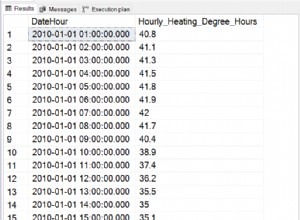Aby osiągnąć to, czego szukasz, musisz użyć wyzwalacze . Nie ma innego bezpośredniego sposobu na wykonanie tego zadania (chyba).
Wypróbowałem teraz szybkie demo:
Create Table SoQuestion (
UserId int,
PostId int,
PostNumber int null
);
CREATE TRIGGER inc_post_num
BEFORE INSERT ON SoQuestion
FOR EACH ROW
set New.PostNumber = (select num
From (select count(*) as num
from SoQuestion
where UserId = New.UserId) as b)
+ 1;
insert into SoQuestion (UserId, PostId) Values (1,1);
insert into SoQuestion (UserId, PostId) Values (1,10);
insert into SoQuestion (UserId, PostId) Values (1,20);
insert into SoQuestion (UserId, PostId) Values (2,1);
insert into SoQuestion (UserId, PostId) Values (2,10);
insert into SoQuestion (UserId, PostId) Values (3,1);
insert into SoQuestion (UserId, PostId) Values (4,1);
select * FROM SoQuestion;
A oto wynik, który otrzymałem:
UserId | PostId | PostNumber |
==============================
1 | 1 | 1 |
1 | 10 | 2 |
1 | 20 | 3 |
2 | 1 | 1 |
2 | 10 | 2 |
3 | 1 | 1 |
4 | 1 | 1 |
Oto demo .
Po przejściu przez Auto_Increment
dokumentacji, znalazłem inny sposób na osiągnięcie tego bez użycia wyzwalaczy. Pomysł polega na stworzeniu Auto_Increment kolumnę i dodaj ją z inną kolumną jako PRIMARY KEY . W naszym przypadku byłby to UserId i AUTO_INCREMENT byłby PostNumber i oba tworzą klucz podstawowy. Oto jak:
Create Table SoQuestion (
UserId int,
PostId int,
PostNumber int NOT NULL AUTO_INCREMENT,
PRIMARY KEY (UserId, PostNumber)
);
insert into SoQuestion (UserId, PostId) Values (1,1);
insert into SoQuestion (UserId, PostId) Values (1,10);
insert into SoQuestion (UserId, PostId) Values (1,20);
insert into SoQuestion (UserId, PostId) Values (2,1);
insert into SoQuestion (UserId, PostId) Values (2,10);
insert into SoQuestion (UserId, PostId) Values (3,1);
insert into SoQuestion (UserId, PostId) Values (4,1);
select * FROM SoQuestion;
To dałoby nam ten sam wynik, co pierwszy sposób:
UserId | PostId | PostNumber |
==============================
1 | 1 | 1 |
1 | 10 | 2 |
1 | 20 | 3 |
2 | 1 | 1 |
2 | 10 | 2 |
3 | 1 | 1 |
4 | 1 | 1 |
A oto demo na drugi sposób.




